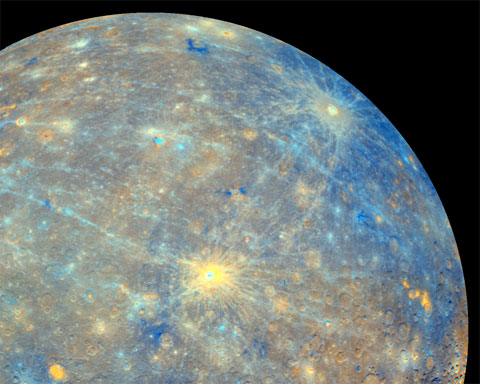Sometimes it's too easy to assume that secrets hide in the darkness: The planet Mercury has been hiding its secrets in the light. And, now NASA's MESSENGER spacecraft has completed its mission, and JAXA/ESAs Bepi-Columbo under construction, it has begun to reveal them.....
 |
| Image above: An enhanced colour view of Mercury, from the MESSENGER space craft - the colours you see here are too subtle for the human eye. Ahh, to be a spaceship.....no, being stranded a billion kilometres into deep space isn't worth it. Image courtesy of NASA/JPL. |
Well, so much for received wisdom: The Moon has turned out to be a complex place with things still going on, and Mercury..... MESSENGER has shown Mercury to be an riddle wrapped around a large, still active, iron core. And the exploration of this world, that bakes in the full electromagnetic and particle fury of the Sun, is just beginning.
Not so dead:
Mercury is still alive and kicking - both deep inside its core and, possibly, on its surface. And it is a massive core - eighty five percent of the planets volume. Because of the planets small size, before MESSENGER, researchers had assumed that the core had cooled solid, and any magnetic field was residual.
Now we know differently: By measuring changes in MESSENGER's velocity near Mercury, the team has been able to build up a map of the planets gravitational field. Combined with measurements from Earth based radar, a working idea of the internal structure of Mercury has been built up: There's a solid crust, then a solid, iron sulfide outer core, and then a liquid core further in.
 |
| Image above: A comparison of the internal structures of Earth an Mercury - though, as you can see from the 'relative sizes' box Mercury would fit nicely inside the core of Earth. Image courtesy of the Case Western Reserve University. |
The field itself is as complex as a very complicated thing
 |
| Image above: An infographic of Mercury, showing the magnetics fields place in the grand scheme of things. Image courtesy of ESA. |
It's shaped similarly to Earths, with an outer bow shock covering the planets sunward face, and a long magnetotail streaming behind. Huge, moving, bubbles of plasma (called plasmoids) travel down the magnetotail towards interplanetary space. And the whole field is wracked by tornadoes in the magnetic field lines [10] - called flux transfer events - eight hundred kilometres across.
 |
| Image above: A simplified map of the magnetic field of Mercury. Yes, that's the simple version. Image courtesy of NASA |
All this adds to the idea of the field being generated by a molten core - a solid core with a relic field wouldn't produce such complex behaviour.
In the northern hemisphere are massive expanses of plains, formed by ultra runny komatiite lava, that hasn't been seen on Earth for billions of years. This lava came pouring out of twenty five kilometre long cracks in the crust, and spread to cover six percent of the planets surface. And these lavas are deep - up to two kilometres, judging by the remains of the craters buried underneath them.
In other areas there are very, very strange hollows - clusters of them. These are like nothing geologists have ever seen, on Earth or any other planet. They are bluer in colour than the rest of Mercury, they look fresh, they occur in places where there's no sign of recent volcanic activity. In fact, as one member of the MESSENGER team has said: "There's a distinct possibility [these hollows] are active today."
That would make Mercury geologically active - although we still have no firm idea of what kind of active geology is forming these things.
These pits look as though something blasted its way up from the subsurface, and one of the leading theories right now is that subsurface deposits of something volatile did just that: Something in the rocks is affected by either the solar wind or the Suns intense heat, and breaks down, either erupting through the crust as a gas, or leading to massive rock collapse as the stones chemical structure falls apart. Or both.
 |
| Image above: Mercury looks like it's going rotten, like the surface of a an old tomato going mouldy. Although the mould is tens of kilometres across, and is actually huge pits in the ground that are opening for no apparent reason. But it sure looks like blue mould. Image courtesy of NASA. |
Messenger has been able to confirm that these mystery deposits are only found at the bottom of craters of eternal night, where the Sun never, ever rises above the crater rim mountains. That's not proof of water, but it is suggestive, and MESSENGER is equipped with a neutron spectrometer that should find out for sure
 |
| Image above: Some of the radar bright deposits, hidden in the bottom of eternally dark craters. Left image from NRAO, Muhleman, 1992; right north polar image from Harmon, NAIC, 2000. |
The overall chemical composition of Mercury is different to the other terrestrial planets, and measurements of the ratio of potassium to thorium show that the planet had a cooler past than expected, and may retain a supply of volatile materials. In fact this puts a lot of theories of how Mercury grew back to the drawing board - and suggests that the little planet might have grown from metal rich chondrite asteroids.
In fact it's been back to the drawing board for a lot of our assumptions about Mercury. And I couldn't be more thrilled to have bunch of new mysteries to wonder over.....
No comments:
Post a Comment